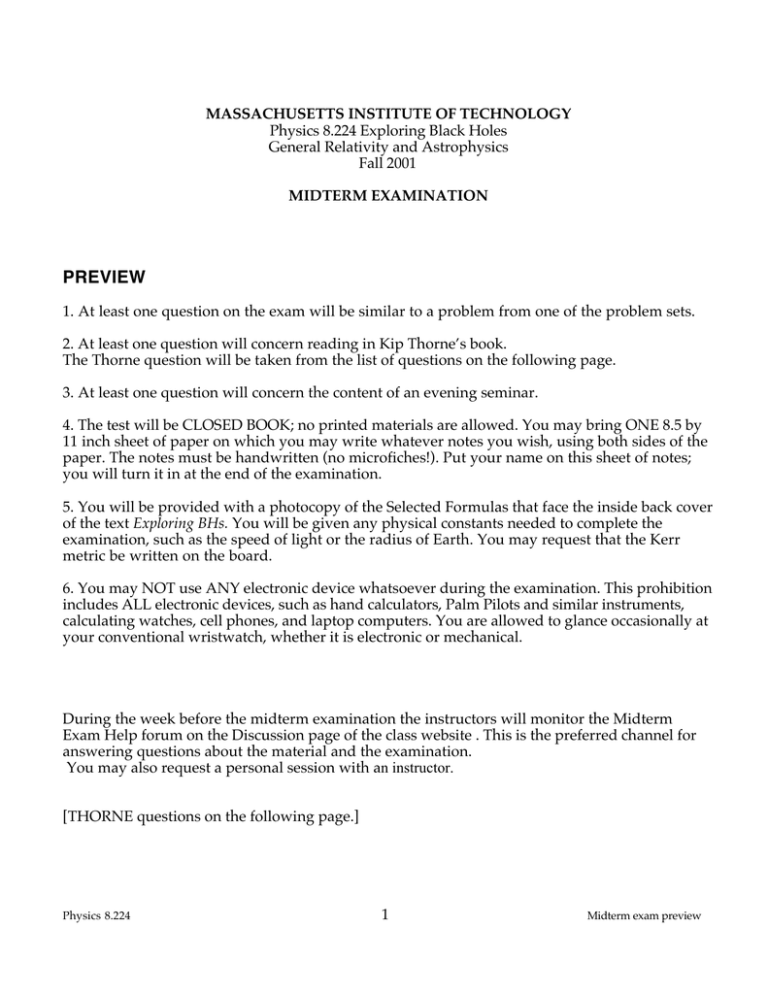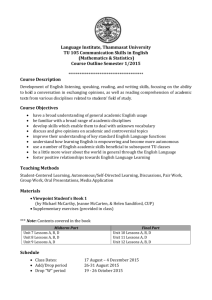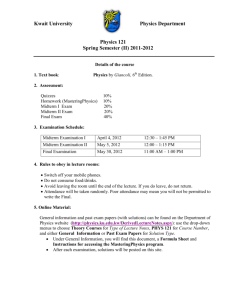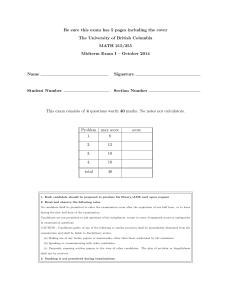Document 13614716
advertisement

MASSACHUSETTS INSTITUTE OF TECHNOLOGY Physics 8.224 Exploring Black Holes General Relativity and Astrophysics Fall 2001 MIDTERM EXAMINATION PREVIEW 1. At least one question on the exam will be similar to a problem from one of the problem sets. 2. At least one question will concern reading in Kip Thorne’s book. The Thorne question will be taken from the list of questions on the following page. 3. At least one question will concern the content of an evening seminar. 4. The test will be CLOSED BOOK; no printed materials are allowed. You may bring ONE 8.5 by 11 inch sheet of paper on which you may write whatever notes you wish, using both sides of the paper. The notes must be handwritten (no microfiches!). Put your name on this sheet of notes; you will turn it in at the end of the examination. 5. You will be provided with a photocopy of the Selected Formulas that face the inside back cover of the text Exploring BHs. You will be given any physical constants needed to complete the examination, such as the speed of light or the radius of Earth. You may request that the Kerr metric be written on the board. 6. You may NOT use ANY electronic device whatsoever during the examination. This prohibition includes ALL electronic devices, such as hand calculators, Palm Pilots and similar instruments, calculating watches, cell phones, and laptop computers. You are allowed to glance occasionally at your conventional wristwatch, whether it is electronic or mechanical. During the week before the midterm examination the instructors will monitor the Midterm Exam Help forum on the Discussion page of the class website . This is the preferred channel for answering questions about the material and the examination. You may also request a personal session with an instructor. [THORNE questions on the following page.] Physics 8.224 1 Midterm exam preview THORNE QUESTIONS One of the following question will appear on the exam. USING 3 TO 7 SENTENCES, ANSWER THE FOLLOWING QUESTION FROM YOUR READING IN THORNE: 1. Why does our Sun not collapse into a black hole? Why does a white dwarf not collapse into a black hole? Why does a neutron star not collapse into a black hole? 2. Explain why the gravitational effect of the moon on Earth’s oceans tends to create a peak in the ocean level on the side of Earth OPPOSITE to that of the moon. 3. Case A: A star of perfect spherical symmetry collapses smoothly to form a Schwarzschild black hole. Case B: A ragged, asymmetrical collection of astronomical objects collapses to form a Schwarzschild black hole. Describe the differences in observations recorded by a remote observer in the two cases. 4. Describe one method for detecting the existence of black holes. (Seven sentences max!) 6. Use Newtonian mechanics to describe and explain the tidal forces experienced by an astronaut who falls freely, feet first, toward a non-rotating black hole. 7. Start with a white dwarf that gradually steals matter from an orbiting companion. Assume no matter is blown away from the accreting structure. Describe the sequence of structures that result, including the approximate radius and mass of each. Which of these structures were unknown to the young Chandrasekhar on his way by boat to Great Britain? 8. Wheeler and Wakano studied cold, dead objects. Why cold and dead rather than hot and evolving? 9. Explain the meaning of the saying. "A black hole has no hair." as it applies to the formation of a black hole. 10. A radio galaxy may have "lobes" hundreds of thousands of light years from the galaxy itself. What physical process leads to radio emission from these lobes? Physics 8.224 2 Midterm exam preview






![BLACK HOLES [Image by A. Hamilton]](http://s2.studylib.net/store/data/011136746_1-55ad6d8c7967ea2fec5195cf1d23ce69-300x300.png)